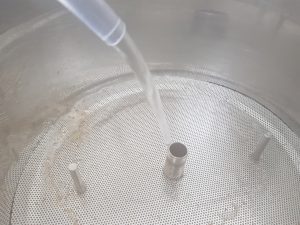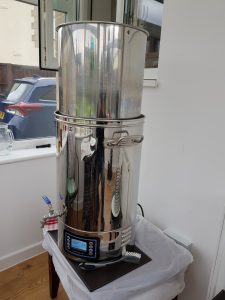Sparging
 The word sparge originates from the Latin term ‘spargere’ meaning to sprinkle. Sparging refers to the rinsing of the mash grain bed to extract as much of the sugars from the grain as possible without extracting tannins from the process. The temperature of the sparge water is important. The water should be no more than 77°C, as husk tannins become more soluble above this temperature, depending on wort pH. This could lead to astringency in the beer. However, if it’s too cool the run off will be less fluid causing less extraction of sugars.
The word sparge originates from the Latin term ‘spargere’ meaning to sprinkle. Sparging refers to the rinsing of the mash grain bed to extract as much of the sugars from the grain as possible without extracting tannins from the process. The temperature of the sparge water is important. The water should be no more than 77°C, as husk tannins become more soluble above this temperature, depending on wort pH. This could lead to astringency in the beer. However, if it’s too cool the run off will be less fluid causing less extraction of sugars.
Sparge liquor is required to be ‘sprinkled’ onto the top of the mash bed, so as not to disturb the mash bed, while the liquid is released from the bottom of the mash tun into the boiler (the vessel for boiling). If the mash tun is equipped with a perforated sieve that sits on top of the mash (like mine, see photo), the sparge liquor can just be run directly onto it (no need to sprinkle).
A technique known as ‘lautering’ could be more thorough at this point. This consists of 3 steps: mashout (raising the temperature to about 77°C), recirculation of the first runnings, and then sparging. In practice, if the wort is recirculated during the mash, and the sparge water is delivered at 77°C, lautering is virtually achieved anyway.
There are three methods of sparging:
- No-sparge brewing which avoids rinsing altogether. The mash is conducted with the full volume of water that goes into the boil kettle. This convenience comes at the price of reduced efficiency and larger equipment requirements.
- Fly-sparge (or continuous-sparge) brewing is the traditional German method of sprinkling hot water over the top of the grain bed while wort is drained from the bottom. This results in a continuous rinsing of sugars from top to bottom. Fly sparging is generally the most efficient sparge method but requires somewhat more careful monitoring than others. I use this method.
- Batch-sparge brewing comes from the traditional commercial British practice of parti-gyle brewing (getting multiple beers out of the same mash and boiling successive runnings separately). In batch sparging, two or three separate runnings are combined into a single wort. Batch sparging is sometimes a touch less efficient than fly sparging, but with practice, it can be as good or better.
 Some home-brew beer equipment is designed to be used for mashing, sparging and boiling, such as the Royal Catering Mash Tun which I use. For sparging, the mash tun is lifted clear of the boiler, and suspended just above it (see photo). The sparging liquor is delivered onto the top of the mash bed, and the hot wort dripping out of the mash tun is gathered in the boiler.
Some home-brew beer equipment is designed to be used for mashing, sparging and boiling, such as the Royal Catering Mash Tun which I use. For sparging, the mash tun is lifted clear of the boiler, and suspended just above it (see photo). The sparging liquor is delivered onto the top of the mash bed, and the hot wort dripping out of the mash tun is gathered in the boiler.
After sparging is complete, the mash ‘porridge’ may be discarded – it makes an excellent garden mulch. In the commercial world the discarded mash is used for cattle feed (it doesn’t contain any alcohol at this stage!).
Regarding quantity of water for sparging, I usually start at about 32 litres total mash plus sparge water, which produces 30 litres in the boiler, which reduces to 27 litres after the boil, which provides about 25 litres in the fermenter. This provides the 18 litres required for a full Cornelius keg plus 6 bottles, allowing for some wastage. The quantity of water required for the mash is a function of the weight of the grist and the desired ‘thickness’ of the mash – refer to the Calculations page. The quantity of sparge water required is then the total (eg. 32 litres) minus the calculated amount of water for the mash.
